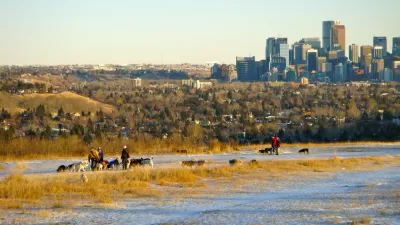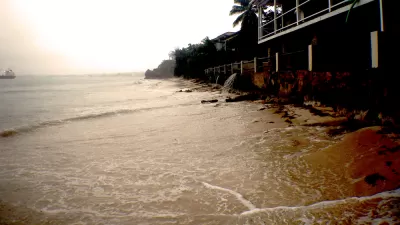The rise of shale oil in Alberta over the past decade has made Calgary one of the most vibrant cities on the continent. But with oil slumping around $50 per barrel, the fortunes of an industry town look less rosy.

While the oil extracted from Alberta's tar sands gets distributed, by train and pipeline, to the far reaches of the continent, much of the profits end up in Calgary. Formerly most famous for its rodeo, Calgary has been the financial headquarters for the decade-long petroleum boom taking place in the Athabasca Oil Sands some 300 miles north of the city. As workers have flooded into Calgary, real estate prices have risen accordingly in the city of 1.2 million. And tastes have changed, as modest homes have given way to McMansions.
But, in an industry town, the fate of the city is tied to the fate of the industry. With the crash in oil prices, banks that serve the industry have seen their stock prices crash. Banks are considered more vulnerable than the oil companies themselves. In January, Calgary's inventory of available housing doubled from the previous January, as home sales fell 39 percent and new listings rose 37 percent. Listing prices have remained steady for the time being. Home prices rose 8.8 percent in 2014.
"The Calgary real-estate market’s health will depend on how long oil prices remain depressed and how low they go. With oil prices down more than 50% from midsummer highs last year and few signs of an imminent rebound, the Calgary housing market is expected to stay depressed for the remainder of the year."
FULL STORY: Slumping Oil Prices Hit Calgary Housing

Alabama: Trump Terminates Settlements for Black Communities Harmed By Raw Sewage
Trump deemed the landmark civil rights agreement “illegal DEI and environmental justice policy.”

Study: Maui’s Plan to Convert Vacation Rentals to Long-Term Housing Could Cause Nearly $1 Billion Economic Loss
The plan would reduce visitor accommodation by 25% resulting in 1,900 jobs lost.

Why Should We Subsidize Public Transportation?
Many public transit agencies face financial stress due to rising costs, declining fare revenue, and declining subsidies. Transit advocates must provide a strong business case for increasing public transit funding.

Paris Bike Boom Leads to Steep Drop in Air Pollution
The French city’s air quality has improved dramatically in the past 20 years, coinciding with a growth in cycling.

Why Housing Costs More to Build in California Than in Texas
Hard costs like labor and materials combined with ‘soft’ costs such as permitting make building in the San Francisco Bay Area almost three times as costly as in Texas cities.

San Diego County Sees a Rise in Urban Coyotes
San Diego County experiences a rise in urban coyotes, as sightings become prevalent throughout its urban neighbourhoods and surrounding areas.
Urban Design for Planners 1: Software Tools
This six-course series explores essential urban design concepts using open source software and equips planners with the tools they need to participate fully in the urban design process.
Planning for Universal Design
Learn the tools for implementing Universal Design in planning regulations.
Smith Gee Studio
Alamo Area Metropolitan Planning Organization
City of Santa Clarita
Institute for Housing and Urban Development Studies (IHS)
City of Grandview
Harvard GSD Executive Education
Toledo-Lucas County Plan Commissions
Salt Lake City
NYU Wagner Graduate School of Public Service



























